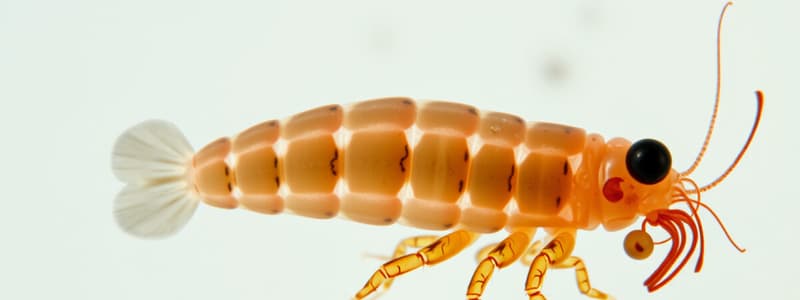Podcast
Questions and Answers
The three types of copepods classified by antennae length are: ____, ____, and ____.
The three types of copepods classified by antennae length are: ____, ____, and ____.
harpacticoid, cyclopoid, calanoid
Describe harpacticoids.
Describe harpacticoids.
Copepods defined by short antennae that live in benthos or in sand grains.
What defines cyclopoid copepods?
What defines cyclopoid copepods?
Copepods defined by medium antennae that live in between the water column and sea floor.
Where do calanoid copepods live?
Where do calanoid copepods live?
What are planktonic copepods known for?
What are planktonic copepods known for?
Describe benthic copepods.
Describe benthic copepods.
What are parasitic copepods?
What are parasitic copepods?
Define endoparasitic copepods.
Define endoparasitic copepods.
What are ectoparasitic copepods known for?
What are ectoparasitic copepods known for?
What is produced by freshwater copepods under poor environmental conditions?
What is produced by freshwater copepods under poor environmental conditions?
What characterizes each nauplius and copepodite stage in their life cycle?
What characterizes each nauplius and copepodite stage in their life cycle?
Five morphological modifications of ectoparasites include reduced segmentation, loss of appendages, ____ body shape, specialized appendages for grasping, and modified mouth for ____.
Five morphological modifications of ectoparasites include reduced segmentation, loss of appendages, ____ body shape, specialized appendages for grasping, and modified mouth for ____.
Two morphological modifications of endoparasites are ____ and the ability to absorb nutrients across the ____.
Two morphological modifications of endoparasites are ____ and the ability to absorb nutrients across the ____.
Flashcards are hidden until you start studying
Study Notes
Types of Copepods
- Harpacticoid copepods have short antennae and inhabit benthic environments, often found in sand grains.
- Cyclopoid copepods have medium-length antennae and typically reside in transitional zones between the water column and sea floor.
- Calanoid copepods possess long antennae and thrive in open ocean environments, primarily within the water column.
Other Types of Copepods
- Planktonic copepods are nocturnal calanoids that engage in vertical migration, adapting to varying depths in the water column.
- Benthic copepods, primarily harpacticoids, inhabit benthos or sand grains and employ various feeding strategies including filter feeding, carnivory, or omnivory.
- Parasitic copepods are classified into two groups:
- Endoparasitic copepods live within hosts, such as polychaetes.
- Ectoparasitic copepods latch onto fish gills, commonly referred to as fish lice.
Life Cycle of Copepods
- Freshwater copepods can produce thick-shelled, dormant eggs during adverse environmental conditions, allowing for survival until conditions improve.
- Copepods go through nauplius and copepodite stages, characterized by a process of molting.
Morphological Modifications of Ectoparasites
- Ectoparasitic copepods exhibit reduced external segmentation, leading to a simplified structure.
- Appendages are either lost or greatly reduced in size, adapting to their parasitic lifestyle.
- Their bodies are typically vermiform (worm-like) rather than torpedo-shaped, aiding in their survival on hosts.
- Specialized appendages are present, designed specifically for grasping their hosts.
- Mouthparts or mandibles are modified to facilitate piercing or sucking, enhancing feeding efficiency.
Morphological Modifications of Endoparasites
- Endoparasitic copepods often exhibit a complete loss of mouth structures, reflecting their nutrient absorption strategy.
- They absorb nutrients directly from their host's body wall, adapting to an internal lifestyle.
Studying That Suits You
Use AI to generate personalized quizzes and flashcards to suit your learning preferences.
